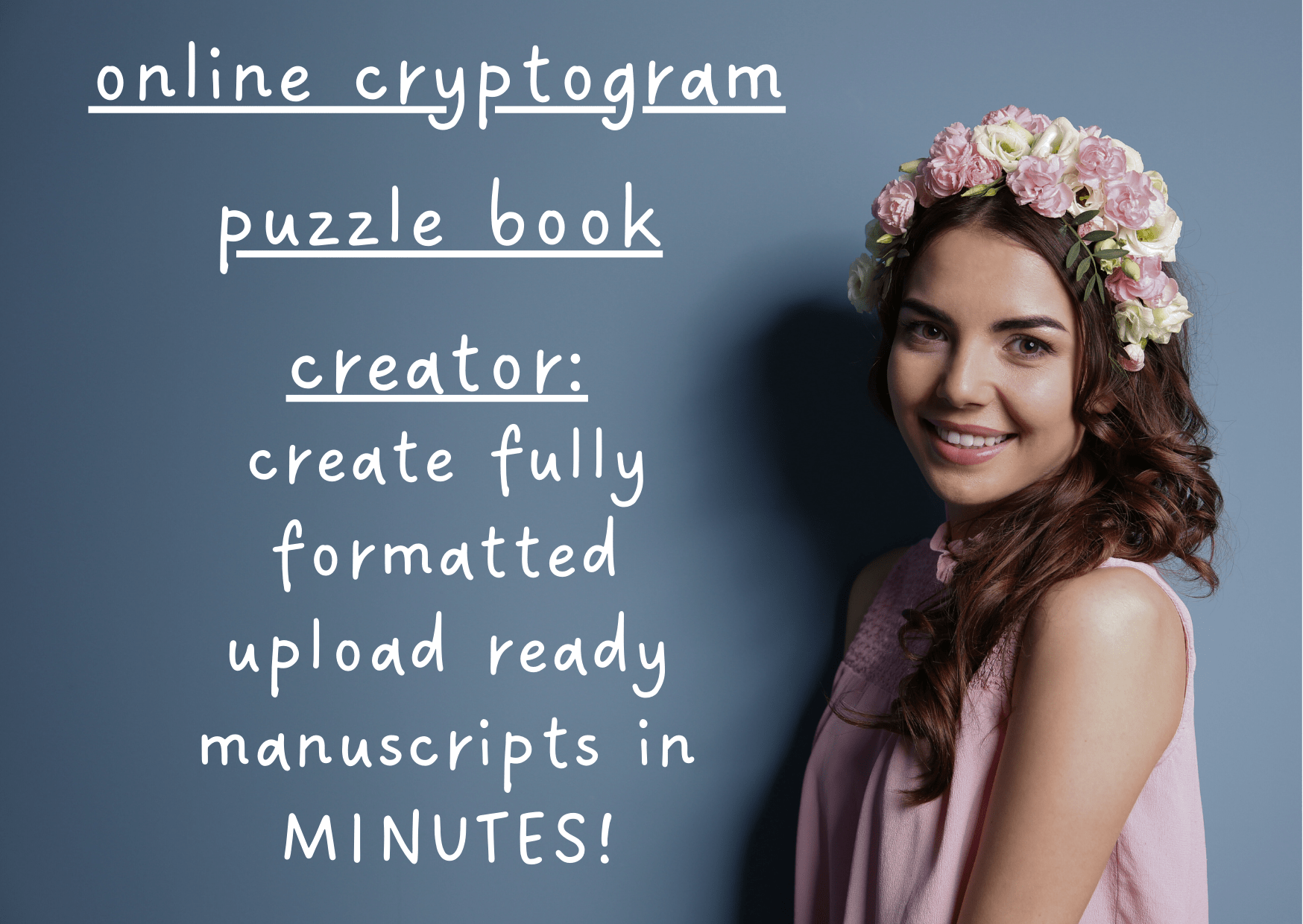cryptogram puzzle books: how to solve, rules of the game, tips and tricks, advanced strategies, how to make money using cryptogram puzzle book creator
This is a how to article by Saffron
table of contents
- how to solve cryptogram puzzles
- detailed explanation of the rules of cryptogram puzzles
- tips and tricks on how to quickly solve cryptogram puzzles
- advanced strategies for solving cryptogram puzzles
- how to make money with cryptogram puzzle books

how to solve cryptogram puzzles
Cryptogram puzzles involve decoding a message where each letter has been replaced by another letter or symbol. Here's a stepbystep guide on how to solve cryptogram puzzles:
1. Understand the Basics:
Recognize that cryptograms involve a simple substitution cipher where each letter in the alphabet corresponds to another letter or symbol.
2. Look for Common Words:
Identify common words in the puzzle, such as "the," "and," or "is." Common words are often the key to breaking the code.
3. Identify SingleLetter Words:
Singleletter words are usually "a" or "I." Identify these to determine potential correspondences.
4. Analyze Patterns:
Look for recurring patterns of letters or symbols. These might represent common letter combinations like "th," "er," or "ing."
5. Use Frequency Analysis:
English has certain letter frequencies. The most common letters are E, T, A, O, I, N, S, H, R, and D. Use this knowledge to identify potential substitutions.
6. Consider Word Lengths:
Pay attention to the lengths of words. Short words are likely to be "a," "I," or common conjunctions.
7. Guess and Check:
Make educated guesses for some letters based on context and common words. Check if the resulting words make sense. This also applies to solving KDP crossword puzzle books for beginners
8. Use Punctuation:
Punctuation marks often remain the same in a cryptogram. Identify them to gain insights into the coded message.
9. Apply Letter Pairs:
Work with common letter pairs, such as "th," "er," "ng," and "he." Identify these pairs to decipher more of the code.
10. Trial and Error:
If you're stuck, use trial and error for certain letters. Substitute different letters and see if the resulting words make sense.
11. Pay Attention to Spaces:
Spaces between words remain the same in a cryptogram. Use them as guides to separate words.
12. Consider Context:
Consider the context of the message. If it's a quote, think about the author's style or the subject matter.
13. Utilize Word Patterns:
As you decipher words, use the patterns to decipher other words. Look for repeated combinations.
14. Check for Common Letter Combinations:
Identify common letter combinations in the English language. This knowledge helps in recognizing patterns and making substitutions.
15. Be Patient:
Solving cryptograms can take time. Be patient and persistent, and don't get discouraged.
16. Use Cryptogram Solving Tools:
Online tools or apps can help you solve cryptograms by automating the process of trying different letter substitutions.
17. Learn Cryptogram Strategies:
Familiarize yourself with common cryptogram strategies, such as substitution patterns, vowel/consonant identification, and letter frequency. Learning from other types of math logic puzzle books also helps
18. Practice Regularly:
The more you practice solving cryptograms, the better you become at recognizing patterns and making accurate substitutions.
Solving cryptogram puzzles is a blend of logic, language knowledge, and pattern recognition. By employing these strategies, you can decipher the coded message and enjoy the challenge of cryptograms.

advanced strategies for solving cryptogram puzzles
Advanced strategies for solving cryptogram puzzles go beyond basic letter frequency analysis and educated guessing. Here are some advanced techniques to tackle more complex cryptograms:
1. Dig into Digraphs:
Analyze common digraphs (pairs of adjacent letters) in the language. Identify recurring patterns like "TH," "CH," or "SH" to reveal multiple letters at once.
2. Trigraphs and Quadrigraphs:
Extend your analysis to trigraphs and quadrigraphs (groups of three or four letters). Recognizing patterns in longer sequences can significantly speed up deciphering.
3. Leverage Word Structure:
Consider the structure of English words. Recognizing prefixes, roots, and suffixes can help break down larger words and unveil letter substitutions.
4. Employ Frequency Analysis on Word Parts:
Apply frequency analysis not just to individual letters but also to common word parts, such as prefixes and suffixes. This is especially useful for longer words.
5. Letter Position Analysis:
Consider the position of letters within words. Certain letters are more likely to appear at the beginning or end of words, aiding in targeted substitutions.
6. Use Bi-Gram and Tri-Gram Probabilities:
Go beyond individual letter frequencies and incorporate bi-gram and tri-gram probabilities. This involves analyzing the likelihood of certain letter combinations occurring together.
7. Contextual Analysis:
Analyze the context of the message. If the cryptogram is a quote, consider the author's writing style, known phrases, or typical expressions used by that author.
8. Homophonic Substitution Recognition:
Recognize homophonic substitutions, where a single plaintext letter can map to multiple different ciphertext symbols. This advanced technique requires a deep understanding of language nuances. This also applies to word search puzzle books
9. XOR Cryptanalysis:
For more advanced cryptograms, consider XOR (exclusive OR) cryptanalysis. This involves bitwise operations and is suitable for cryptographic-level puzzles.
10. Frequency Analysis of Word Lengths:
Extend frequency analysis to word lengths. Determine common word lengths in the language, and use this information to deduce possible substitutions for certain patterns.
11. Vowel and Consonant Analysis:
Analyze the distribution of vowels and consonants in the puzzle. Recognizing these patterns can lead to more accurate substitutions.
12. Statistical Language Models:
Utilize statistical language models or artificial intelligence tools designed for cryptanalysis. These tools employ advanced algorithms to analyze language patterns and provide insights.
13. Crossword Puzzle Skills:
If the cryptogram forms part of a larger puzzle, apply crossword puzzle-solving skills. Cross-referencing with other clues may provide additional hints.
14. Pattern Recognition Software:
Explore pattern recognition software that can assist in identifying recurring patterns and suggesting likely substitutions.
15. Study Historical Cryptography Methods:
Familiarize yourself with historical cryptography methods. Knowledge of classical ciphers and encryption techniques can offer insights into possible substitution methods.
16. Collaborative Solving:
Collaborate with others to solve complex cryptograms. Different perspectives and expertise can enhance the solving process.
17. Learn from Experts:
Study cryptograms created by experts or cryptanalysts. Analyzing their work can provide valuable insights into advanced cryptogram-solving techniques.
18. Use Cryptography Literature:
Refer to literature on cryptography for advanced techniques. Understanding cryptographic principles can enhance your problem-solving skills.
19. Attend Cryptography Courses:
Consider attending cryptography courses or workshops. Formal education in cryptography can deepen your understanding and proficiency in cryptogram solving.
20. Stay Updated on Cryptographic Advances:
Stay informed about recent advances in cryptography. New techniques may provide innovative approaches to solving challenging cryptograms.
Remember, solving advanced cryptograms requires a combination of analytical thinking, linguistic skills, and knowledge of cryptographic principles. Patience and persistence are crucial when dealing with complex puzzles.

how to make money with cryptogram puzzle books
Our online puzzle creator simplifies the generation of puzzle books suitable for Kindle Direct Publishing (KDP) in PDF format, with a specific focus on cryptogram puzzle books.
To create a puzzle book exclusively featuring cryptogram puzzles:
- Click on the cryptogram puzzle type within the app.
- Input the details of your puzzle book, specifying the desired number of pages and manuscript dimensions.
- Click the "Generate" button and patiently await the completion of the generation process.
During the generation process, refrain from closing the tab. If there's a delay or an error, initiate the regeneration process, as errors are typically associated with the hosting provider used during app development.
Our online puzzle creator embraces a unique pricing structure, foregoing monthly or yearly subscriptions in favor of a flat rate per manuscript.
Once generated, the system provides a watermarked preview copy, enabling users to assess and test the puzzle book on various platforms for acceptability.
Satisfied users can proceed to make a one-time payment of $5 to obtain a full manuscript without watermarks.
This pricing strategy aims to offer a fair and transparent cost, eliminating recurring fees for users exploring the full utility of the service. The $5 fee is considered reasonable, taking into account the time and potential expenses saved.
"-to your success"